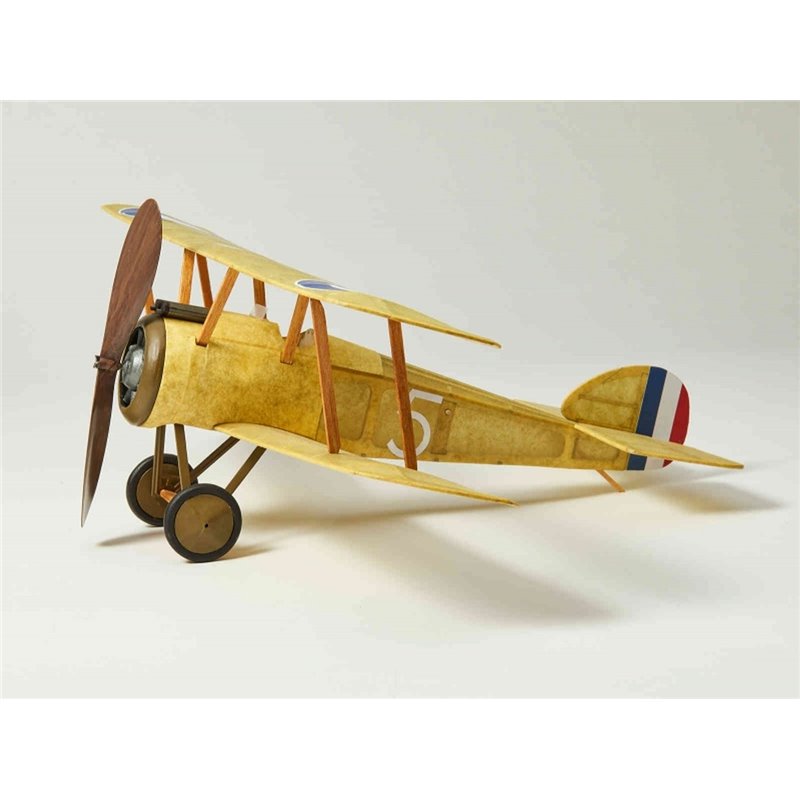





RC MODEL STORE The Fastest growing name in Radio Control






Arguably the most famous and deadliest British aircraft of World War One, the Sopwith F1 Camel was designed by Herbert Smith as a replacement for his earlier design the Sopwith Pup.
The Pup was being outclassed by German aircraft such as the Albatross DIII and a faster, more heavily armed replacement was required. The Pup was relatively easy to fly with somewhat benign characteristics, however the F1 was not.
The powerful Clerget rotary engine created powerful gyroscopic forces that coupled with the torque made the aircraft able to turn to the right very quickly but with a nose down tendency. These dynamic forces plus a nose heavy weight distribution made the aircraft manoeuvrable and a fearsome foe - but tricky to fly. This often ended in disaster especially for inexperienced pilots.
The F1 was the first British aircraft to have guns that fired through the propeller disc via a synchronising gear. These guns were mounted forward of the cockpit with the breeches housed in a "hump". This hump gave the F1 the unofficial nickname of "Camel", which became synonymous with the aircraft despite it never being an official designation.
Along with its stablemate the SE5A, the Sopwith Camel gave the RCF, RNAS and emerging RAF air superiority over the Luftstreitkrafte towards the end of the war.
This kit is designed for you to build a traditionally constructed, rubber powered, free flight model of a 1918 Sopwith F1 Camel of No.13 Squadron RNAS.
The No. 13 Squadron RNAS (latterly 213 Squadron RAF) provided cover for naval sea planes and shipping, before supporting the Belgian army towards the end of the war.
This is a simple but striking scheme, but you can decide to do your own favourite or more complicated scheme if you wish as there are a vast number of Camel schemes to choose from.
Construction of the model from this kit uses the traditional method of "stick and tissue", that consists of a built up balsa wood skeleton (framework), covered with a tissue skin. The balsa frameworks are built over a plan that is printed at the exact scale of the model, which is in essence a real engineering drawing.
Power is provided by rubber strip motor that is wound up before flight. Free flight means just that - once the model is launched, it is on its own. It must follow a predetermined flight path established when the model is initially adjusted for flight or "trimmed".
This type of traditional building technique and flying requires a degree of patience and skill, but is extremely rewarding.
Typically for a small model and in the spirit of the traditional kits, profiles are simplified and adjusted from the original and a relatively large propeller is used. This is done so that the model is light and stable enough to fly on its own, is simple in construction and can work with the rubber motor.
These adjustments have been done with care and sensitivity so that the shape and spirit of the original aircraft is preserved as much as possible.
Also in the spirit of the traditional kits, additional items required to build the model are things that can be found in the kitchen drawer or are easily available on the high street.
Four balsa sheets with precise laser cut parts and strip wood.
PVA glue for building the wooden frames.
One 150mm diameter plastic propeller.
One pre-bent motor hook and shaft.
Small piece of thin acetate sheet for the upper wing window.
Small piece of thick acetate sheet for the screen.
Three low friction plastic "nose" bushings - one for the propeller and two for the undercarriage wheels.
Piano wire for the main undercarriage legs.
A matchstick for the tail skid.
One motor peg (cocktail stick or toothpick).
A plastic drinking straw (approximately 5mm in diameter).
Rubber motor strip.
Tissue to cover the model.
Parts reference sheets (W), full size summary plan sheets (X), scheme diagram sheet (Y) and scheme markings (Z) printed on lightweight paper.
No customer reviews for the moment.

check_circle
check_circle